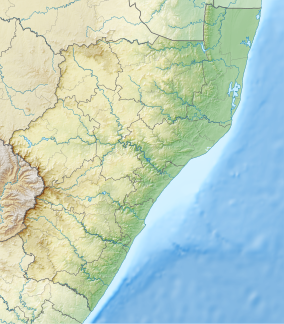
Kaziranga National Park is a national park in the Golaghat and Nagaon districts of the state of Assam, India. The sanctuary, which hosts two-thirds of the world's great one-horned rhinoceroses, is a World Heritage Site. According to the census held in March 2018 which was jointly conducted by the Forest Department of the Government of Assam and some recognized wildlife NGOs, the rhino population in Kaziranga National Park is 2,413. It comprises 1,641 adult rhinos ; 387 sub-adults ; and 385 calves. In 2015, the rhino population stood at 2401. Kaziranga is home to the highest density of tigers among protected areas in the world, and was declared a Tiger Reserve in 2006. The park is home to large breeding populations of elephants, wild water buffalo, and swamp deer. Kaziranga is recognized as an Important Bird Area by BirdLife International for conservation of avifaunal species. When compared with other protected areas in India, Kaziranga has achieved notable success in wildlife conservation. Located on the edge of the Eastern Himalaya biodiversity hotspot, the park combines high species diversity and visibility.

The Central Catchment Nature Reserve is the largest nature reserve in Singapore, occupying 2880 hectares Forming a large green lung in the geographical centre of the city, it houses several recreational sites, including the Singapore Zoo, the Night Safari and the River Safari, as well as several newer facilities built to encourage public appreciation of the reserve, such as the HSBC TreeTop Walk. The reserve sits within the boundaries of the Central Water Catchment. It is one of the four gazetted nature reserves in Singapore. The other three are the Labrador Nature Reserve which was gazetted since 1 January 2002, Sungei Buloh Wetland Reserve and Bukit Timah Nature Reserve. All four nature reserves along with the parks are protected under the Parks & Trees Act 2005.
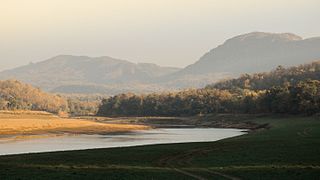
Satpura Tiger Reserve (STR) also known as Satpura National Park is located in the Hoshangabad district of Madhya Pradesh in India. Its name is derived from the Satpura range. It covers an area of 524 km2 (202 sq mi). Satpura National Park, along with the adjoining Bori and Pachmarhi wildlife sanctuaries, provides 2,200 km2 (850 sq mi) of unique central Indian highland ecosystem. It was set up in 1981.
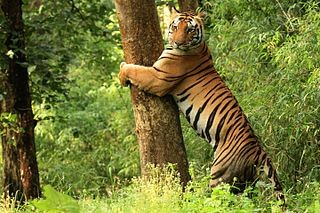
Kanha Tiger Reserve, also called Kanha National Park, is one of the tiger reserves of India and the largest national park of Madhya Pradesh, state in the heart of India. The present-day Kanha area is divided into two sanctuaries, Hallon and Banjar, of 250 and 300 km2 respectively. Kanha National Park was created on 1 June 1955 and in 1973 was made the Kanha Tiger Reserve. Today it stretches over an area of 940 km2 in the two districts Mandla and Balaghat.

Kakamega Forest is a tropical rainforest situated in the Kakamega and Kisumu Counties of Kenya, northwest of the capital Nairobi, and near to the border with Uganda. It is Kenya's only tropical rainforest and is said to be Kenya's last remnant of the ancient Guineo-Congolian rainforest that once spanned the continent.
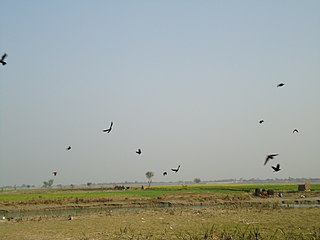
The Koshi Tappu Wildlife Reserve is a protected area in the Terai of eastern Nepal covering 175 km2 (68 sq mi) of wetlands in the Sunsari, Saptari and Udayapur Districts. It comprises extensive mudflats, reed beds, and freshwater marshes in the floodplain of the Sapta Kosi River, and ranges in altitude from 75 to 81 m. It was established in 1976 and designated as a Ramsar site in December 1987.

Gorumara National Park is a National Park in northern West Bengal, India. Located in the Dooars region of the Himalayan foothills, it is a medium-sized park with grasslands and forests. It is primarily known for its population of Indian rhinoceros. The park has been declared as the best among the protected areas in India by the Ministry of Environment and Forests for the year 2009.

Nigula Nature Reserve is a nature reserve situated in South-West of Estonia, in Häädemeeste and Saarde parishes of Pärnu County. It has an area of 63.98 km². Nigula nature reserve is one of the oldest bog reserves in Estonia. It is established to protect the Nigula Bog and its surrounding forests in their natural state.
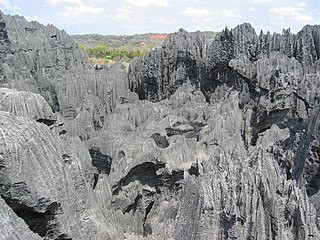
Tsingy de Bemaraha Strict Nature Reserve is a nature reserve located near the western coast of Madagascar in Melaky Region at 18°40′S44°45′E. The area was listed as a UNESCO World Heritage Site in 1990 due to the unique geography, preserved mangrove forests, and wild bird and lemur populations.
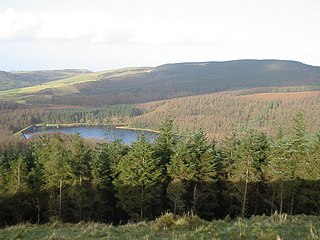
Trentabank Reservoir is located within Macclesfield Forest, partly in the Peak District National Park in England, and is home to rich unimproved uplands and grasslands. The reservoir is surrounded mainly by coniferous plantations and is also home to about 22 pairs of herons.

The wildlife of Botswana refers to the flora and fauna of Botswana. Botswana is around 90% covered in savanna, varying from shrub savanna in the southwest in the dry areas to tree savanna consisting of trees and grass in the wetter areas. Even under the hot conditions of the Kalahari Desert, many different species survive; in fact the country has more than 2500 species of plants and 650 species of trees. Vegetation and its wild fruits are also extremely important to rural populations living in the desert and are the principal source of food, fuel and medicine for many inhabitants.
The Chari-Dhand wetland conservation reserve is located on the edge of arid Banni grasslands and the marshy salt flats of the Rann of Kutch in Kutch District, Gujarat State in India. It is currently legally protected under the status as a Protected or Reserve Forest in India. Chari means salt affected and Dhand means shallow wetland, Dhand is a Sindhi word for a shallow saucer shaped depression. This is a seasonal desert wetland and only gets swampy during a good monsoon, receiving water from the north flowing rivers as well as from the huge catchment areas of many surrounding big hills. It is spread over an area of 80 km2. It is in Nakhtrana Taluka, 80 km south west to the city of Bhuj, about 7 or 8 km from Fulary village and 30 km from Nakhtrana town. It is home to nearly two lakh birds with migratory and endangered species of birds flocking into the area in thousands during monsoon and winters.

Scratchwood is an extensive, mainly wooded, country park in Mill Hill in the London Borough of Barnet. The 57-hectare site is a Site of Metropolitan Importance for Nature Conservation and together with the neighbouring Moat Mount Open Space it is a Local Nature Reserve.

Gunnersbury Triangle is a 2.57-hectare (6.4-acre) local nature reserve in the London boroughs of Ealing and Hounslow, immediately to the east of Gunnersbury. It was created in 1983 when, for the first time in Britain, a public inquiry ruled that a planned development of the land could not go ahead because of its value for nature. It opened as a nature reserve in 1985.

Palmiet Nature Reserve is located in Westville, a town located ten kilometres from Durban, South Africa. The reserve is made up of a wide variety of natural habitats ranging from forests to grassland. Hundreds of bird species have been recorded and the tree list is extensive. There are a number of self-guided trails that include river crossings.

Daneway Banks is a 17-hectare (42-acre) biological Site of Special Scientific Interest in Gloucestershire, notified in 1954 and renotified in 1983. It lies half a mile west of Sapperton and is part of a group of wildlife sites in the Frome Valley that includes Siccaridge Wood and Sapperton Canal reserves. The site is in the Cotswold Area of Outstanding Natural Beauty.

Dymock Woods is a 53-hectare (130-acre) biological Site of Special Scientific Interest in Gloucestershire, notified in 1990. The site is listed in the 'Forest of Dean Local Plan Review' as a Key Wildlife Site (KWS).
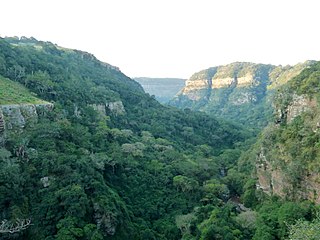
The Krantzkloof Nature Reserve, managed by Ezemvelo KZN Wildlife, conserves 668 ha of the Molweni and Nkutu River gorges that incise the sandstone Kloof plateau in KwaZulu-Natal, South Africa. The reserve conserves coastal scarp forest, sourveld grassland, a cliff face biotope, and aquatic environments along its rivers. Scarp forest is a threatened forest type, protected by South Africa's forests act of 1998, while the grassland is classified as KwaZulu-Natal sandstone sourveld, the most threatened terrestrial habitat in the Durban metropole. The reserve was established in 1950 and was augmented by land donations as late as 1999.

Alverstone Wildlife Park is a 100 hectare nature reserve near Hillcrest, Durban, South Africa. The reserve was created in 1997 by a group of neighbouring landowners.

New Germany Nature Reserve is a protected area of coastal grassland and forest overlooking the suburb of New Germany outside of Pinetown, Durban, South Africa. The reserve consists of a nature park featuring a walk-through aviary and snake display, and grasslands to the south of the park which can be explored by foot.




